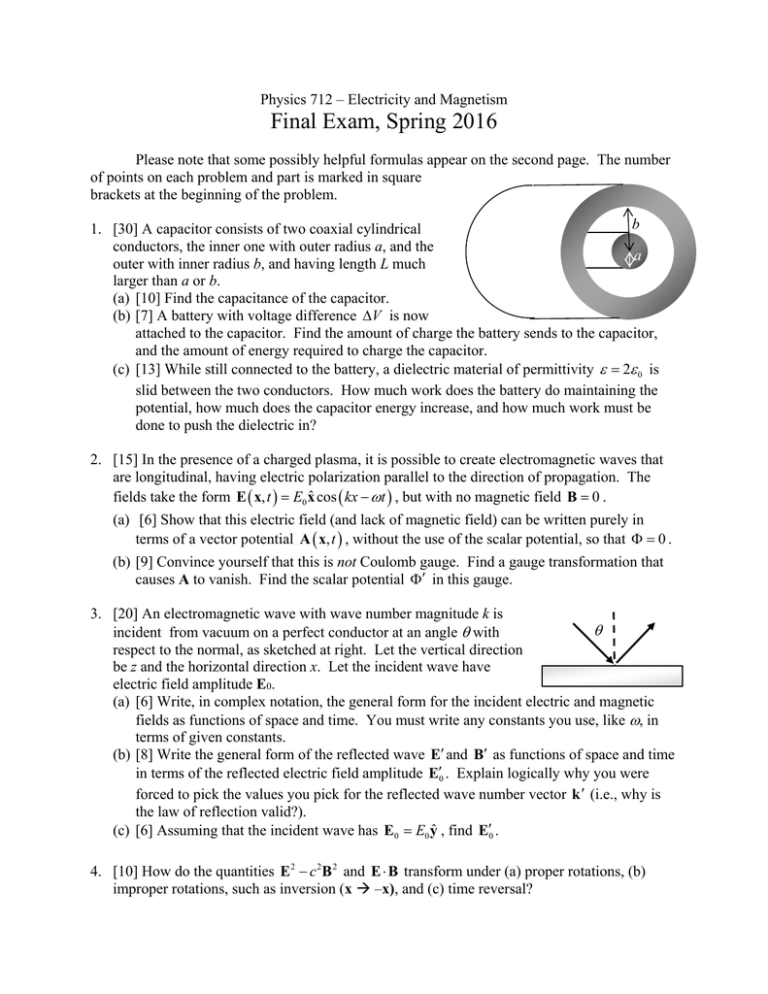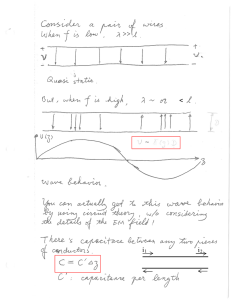Final Exam, Spring 2016
advertisement

Physics 712 – Electricity and Magnetism Final Exam, Spring 2016 Please note that some possibly helpful formulas appear on the second page. The number of points on each problem and part is marked in square brackets at the beginning of the problem. b 1. [30] A capacitor consists of two coaxial cylindrical conductors, the inner one with outer radius a, and the a outer with inner radius b, and having length L much larger than a or b. (a) [10] Find the capacitance of the capacitor. (b) [7] A battery with voltage difference V is now attached to the capacitor. Find the amount of charge the battery sends to the capacitor, and the amount of energy required to charge the capacitor. (c) [13] While still connected to the battery, a dielectric material of permittivity 2 0 is slid between the two conductors. How much work does the battery do maintaining the potential, how much does the capacitor energy increase, and how much work must be done to push the dielectric in? 2. [15] In the presence of a charged plasma, it is possible to create electromagnetic waves that are longitudinal, having electric polarization parallel to the direction of propagation. The fields take the form E x, t E0 xˆ cos kx t , but with no magnetic field B 0 . (a) [6] Show that this electric field (and lack of magnetic field) can be written purely in terms of a vector potential A x,t , without the use of the scalar potential, so that 0 . (b) [9] Convince yourself that this is not Coulomb gauge. Find a gauge transformation that causes A to vanish. Find the scalar potential in this gauge. 3. [20] An electromagnetic wave with wave number magnitude k is incident from vacuum on a perfect conductor at an angle with respect to the normal, as sketched at right. Let the vertical direction be z and the horizontal direction x. Let the incident wave have electric field amplitude E0. (a) [6] Write, in complex notation, the general form for the incident electric and magnetic fields as functions of space and time. You must write any constants you use, like , in terms of given constants. (b) [8] Write the general form of the reflected wave E and B as functions of space and time in terms of the reflected electric field amplitude E0 . Explain logically why you were forced to pick the values you pick for the reflected wave number vector k (i.e., why is the law of reflection valid?). (c) [6] Assuming that the incident wave has E0 E0 yˆ , find E0 . 4. [10] How do the quantities E2 c 2 B 2 and E B transform under (a) proper rotations, (b) improper rotations, such as inversion (x –x), and (c) time reversal? 5. [10] How does the quantity E B transform under a Lorentz boost in the x-direction? 6. [30] A particle with charge q and mass m, initially at rest at = 0 is placed in a uniform electric field E Exˆ . (a) [8] Find a set of coupled differential equations for the derivatives of the four-velocity U as functions of time. (b) [12] Find the solution of the equations from part (a) subject to appropriate boundary conditions at = 0. (c) [10] A proton has mass m 1.673 1027 kg 938.3 MeV/c 2 and charge q e 1.602 1019 C . It is placed in a constant electric field E 1.000 V/m . How much proper time (in seconds) will it take to reach 99% of the speed of light? 7. [35] A waveguide filled with vacuum is in the shape of 45-45-90 triangle, with legs of size a, with boundaries at y = 0, x = a, and y = x. Consider a potential mode function of the form y x, y B cos x C cos y . x (a) [15] By considering the boundary at y = 0, determine if this would work for a TE or TM mode. By considering the other two boundaries, find suitable conditions on , B, and C. (b) [8] Check that it satisfies the mode equation, and determine . (c) [7] Write out explicitly the wave function Ez or Bz (whichever is appropriate) as a function of space and time, if it has wave number k in the z-direction, explicitly giving an expression for the frequency . (d) [5] We now modify this waveguide by making it into a cavity by adding conductors at z = 0 and z = a. What restrictions does this impose? Find a formula for the frequencies , and find the lowest frequency. Possibly helpful formulas: EM Forces d p qF U d Boosts and Fields E E , B B E E v B B B v E c 2 F Relativistic EM Fields Ex c E y c Ez c 0 Ex c 0 Bz By Ey c Bz 0 Bx Bx 0 Ez c By



![Hints to Assignment #12 -- 8.022 [1] Lorentz invariance and waves](http://s2.studylib.net/store/data/013604158_1-7e1df448685f7171dc85ce54d29f68de-300x300.png)